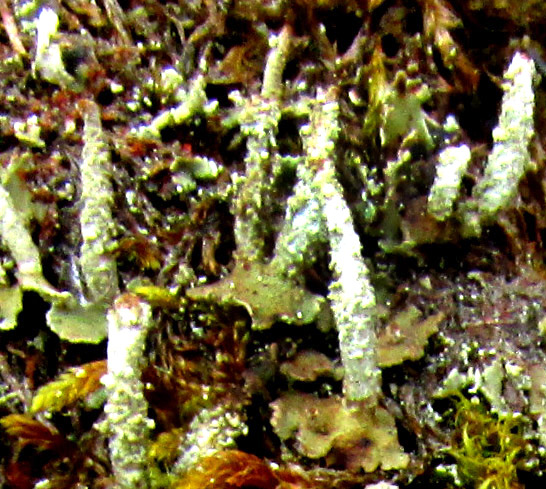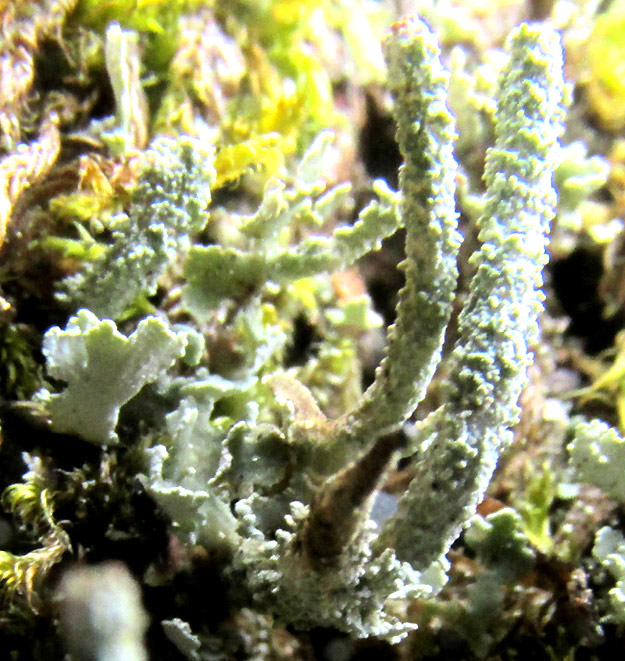Excerpts from Jim Conrad's
Naturalist Newsletter
Entry dated April 19, 2024, from notes taken about 1.5km northeast of Puerto de los Velazquez, Municipality of Pinal de Amoles; N21.138°, W99.667°, elevation ~2820 meters (~9220 feet); oak/pine/fir forest features are on limestone bedrock; in the Eastern Sierra Madre Mountains of east-central Querétaro state, MÉXICO
LIPSTICK POWDERHORN LICHEN

On a steep, north-facing slope, a big pine had died, a large sheet of its rotting, thick bark had sloughed off, and lay face-up where it had slid downslope, on the forest floor. In this semi-cloud-forest zone, tree trunks bear many mosses and lichens, which atop the cast-off bark were still healthy looking, as shown above.
I'd not seen such white, fingerlike organisms before, and at first it hadn't been clear whether the white fingers were fungi or lichens, the latter of course being partly fungus. I'd seen somewhat similar fungi, for example the Candlesnuff, but this was different, and later I couldn't find a fungus exactly like these white little fingers.

At the right, a closer look shows that the white fingers arise from horizontally growing, small, somewhat rounded, greenish-gray sheets. In the picture's center, two fingers arise from a single sheet. The fingers' surfaces are so conspicuously grainy or flaky that I couldn't recall seeing any small fungus with such a covering. However, as a budding naturalist back in Kentucky, the very first lichen of which I learned the name, the British Soldier Lichen, did produce such upright thalli bearing tiny bumps.

At the left, closer up, it's seen how the flake- or scale-like items from which the fingers arise have loose, frilly margins, like many crustose lichens, so now I'm thinking "lichen."
British Soldier Lichens are members of the genus Cladonia, which embraces about 475 currently recognized species. Lichens in that genus not only can produce slender, upright thalli which are warty like our lichen's, but also the thalli often are of same gray hue. A check to see if Cladonia species occur in upland central Mexico produced a list of about a dozen species which have been documented here. By comparing our lichen with images of those species, the only taxon whose features perfectly matched ours was CLADONIA MACILENTA. That species is known by various English names, one of them being Lipstick Powderhorn.
Cladonia macilenta occurs worldwide wherever it's not extremely cold or dry. Seeing our pictures, one might wonder about the lipstick part of the English name. Internet images of the species reveal that when it's the right season and conditions are amenable, as with the British Soldier Lichen, bright red, knobby, spore-producing apothecia form atop the lichen body.
This species is regarded not as a bushy fruticose lichen, but rather as one of the less commonly occurring squamulose kind. Squamulose lichens are thought of as intermediate between crustose and foliose. Squamulose lichens usually manifest as tightly clustered, scale-like bodies growing side by side, as with the Fishscale Lichen. Cladonia macilenta does produce a horizontally growing, scale-like body from which one or more "fingers" arise, but in this species the conspicuous feature is the fingers.
The fingers are known as podetia. Podetia are defined as upright, secondary thalli in lichens of the genus Cladonia. In our species, the podetia are unbranched, or only infrequently branched. Unlike most lichens, in this species, no cup-like, spore-producing apothecia are produced at all. The species mainly appears on dead wood and at tree bases, though sometimes it's found on soil or rocks.
Sometimes Cladonia macilenta is separated into two species which look exactly alike. The difference between them is that the bodies of one species contains thamnolic acid, while the other species doesn't. The difference can be determined by seeing color reactions caused by dripping solutions of potassium hydroxide or para-phenylenediamine on the thalli. Such chemical-based taxa are regarded as chemotypes; some experts recognize them and others don't. LichenPortal.Com's Cladonia macilenta page reports that in the Sonoran region, one chemotype occurs inland, while the other is more frequent in coastal lowlands.
In the 2021 review by Mei-Xia Yang and others entitled "Ethnolichenology -- The Use of Lichens in the Himalayas and Southwestern Parts of China," it's reported that in China Cladonia macilenta has been used as a raw material for antibiotics, and for making a litmus reagent.
The 2013 study by Sook-Young Park and others entitled "Draft Genome Sequence of Cladonia macilenta KoLRI003786, a Lichen-Forming Fungus Producing Biruloquinone," it's reported that our lichen is capable of producing "... an acetylcholinesterase inhibitor, biruloquinone, which effectively prevents neurodegeneration in Alzheimer’s disease."